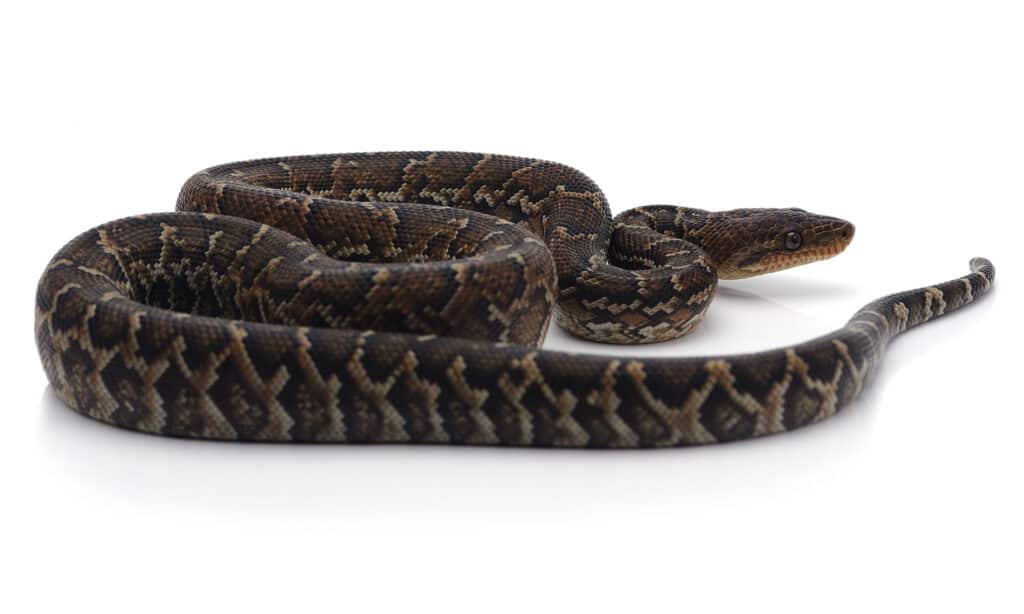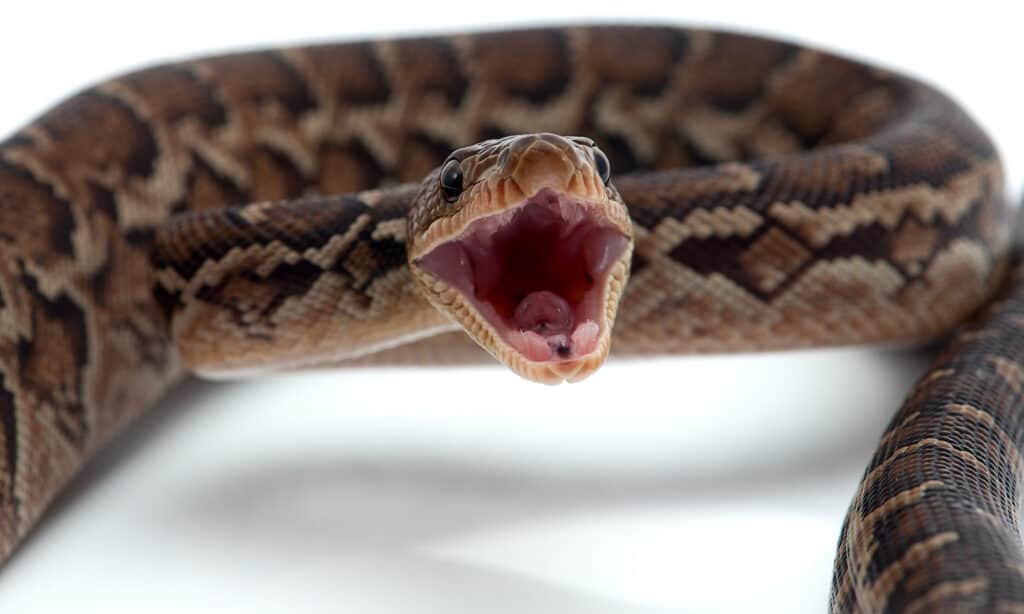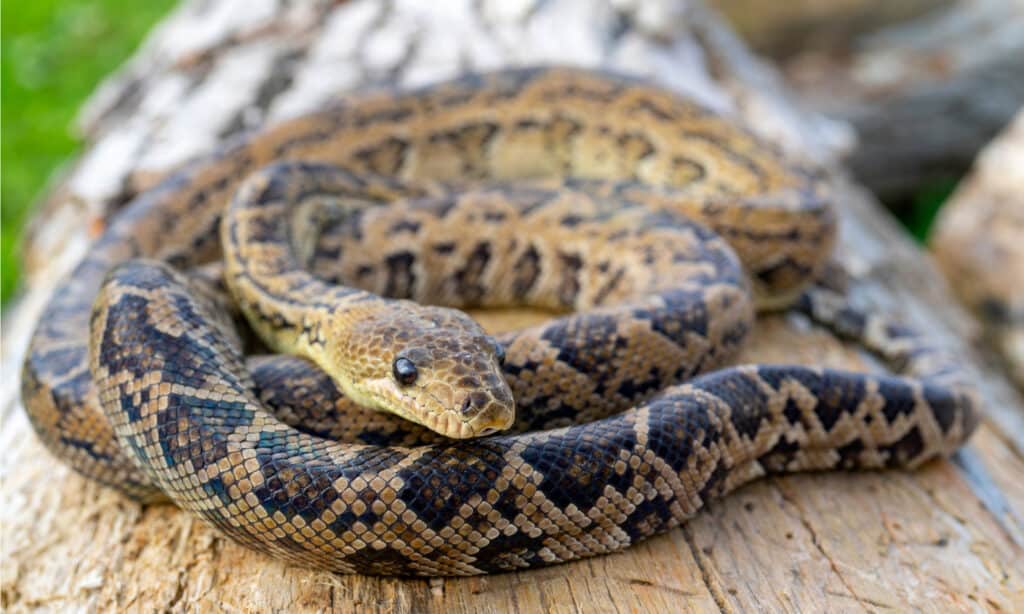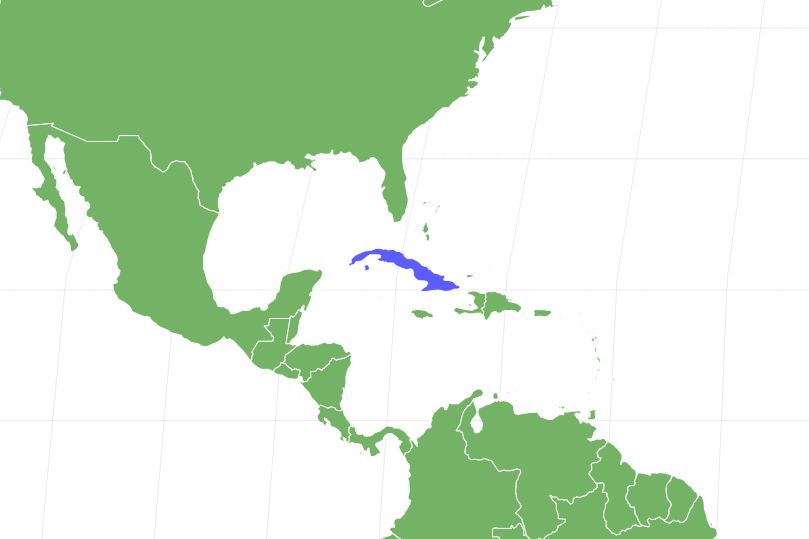Cuban Boa
Chilabothrus angulifer
One of the only snakes observed using cooperative hunting tactics.
Advertisement
Cuban Boa Scientific Classification
- Kingdom
- Animalia
- Phylum
- Chordata
- Class
- Reptilia
- Order
- Squamata
- Family
- Boidae
- Genus
- Chilabothrus
- Scientific Name
- Chilabothrus angulifer
Read our Complete Guide to Classification of Animals.
Cuban Boa Conservation Status
Cuban Boa Facts
- Prey
- Bats, rats, birds, hutias
- Main Prey
- Bats, birds
- Name Of Young
- Neonate
- Group Behavior
- Solitary/Group
- Fun Fact
- One of the only snakes observed using cooperative hunting tactics.
- Biggest Threat
- Habitat destruction
- Most Distinctive Feature
- Angular, geometric markings
- Other Name(s)
- Locally, it goes by a few names, including Cuban tree boa, Boa de Cuba, and Maja de Santa Maria.
- Gestation Period
- 5-6 months, depending on temperature.
- Litter Size
- 2-30
- Lifestyle
- Nocturnal
- Diurnal
- Location
- Cuba and surrounding islands
Cuban Boa Physical Characteristics
- Color
- Brown
- Grey
- Fawn
- Black
- Tan
- Dark Brown
- Caramel
- Skin Type
- Scales
- Lifespan
- 20+ years
- Length
- Up to 21 feet, but most average from 6-9
- Age of Sexual Maturity
- 3-5 years
- Venomous
- No
- Aggression
- Low
View all of the Cuban Boa images!
Cuban boas hang out in caves while they hunt bats, their favorite prey item.
The largest native predator on the island nation of Cuba also happens to be the only boa species on the island. The Cuban boa may grow up to 21 feet long and is an active nocturnal hunter.
Amazing Facts About Cuban Boas
- This boa is the longest of the Chilabothrus group of West Indies boas; some reach 21 feet long. In a sad accident, a 15-foot, 11-inch female was found after being run over by a truck.
- These snakes sometimes hunt cooperatively, by forming a “curtain of snakes” along the top edge of a cave entrance.
- A female can give birth to up to 30 babies every other year.
Where to find a Cuban Boa
This species is native to Cuba and some of the surrounding islands. According to the IUCN assessment, Cuban boas inhabit various forest areas such as tropical rainforests, evergreen forests, evergreen forest swamps, and semi-deciduous forests. They also occur in thor forests, coastal scrub, and sugar cane plantations.
This is a versatile snake that can be found in the holes of trees, caves, and in the trees. It often takes refuge in caves, because it eats bats more than any other animal. However, it will also take juvenile tortoises, dusky dwarf boas (Tropidophis melanurus), mice, hutias, and birds.
Serpentine Pack Hunters
A study published in 2017 showed that this species hunts cooperatively. The researchers observed that snakes that lived near a cave where bats roosted had a pattern wherein they would hang from the cave entrance 10-60 minutes ahead of the mass entrance or exit. Researchers don’t know how widespread this practice is among snake species, but this is one of the few times they have been able to directly observe it.
Hunting Styles May Vary
According to a study published in 2020, this species is a generalist that adjusts its feeding and hunting styles to match its habitat. Snakes that lived near humans were mostly nocturnal and used both ambush predator and active hunting styles; whereas those boas that lived in wild forests were active day and night and were active predators more often than not.
Reproduction
Cuban boas, like other boa species, give birth instead of laying eggs. Between April and June, males compete for the right to court a female, which only mates every other year. In this species, it seems to be size rather than age that determines whether a female can reproduce.
After successful mating, females carry the babies for between five and six months; ambient temperature (as with other reptiles), affects their gestation period. Each female gives birth to between two and 30 young, and the larger the female, the larger the litter and baby size.
Cuban Boa Scientific Name
Over the last 150 years or so, the Cuban boa’s scientific name has alternated between Epicrates angulifer and Chilabothrus angulifer. Right now, most scientists refer to it as Chilabothrus angulifer.
Several boas endemic to islands in the West Indies fall under the auspices of the Chilabothrus genus. The generic name came from Greek; it roughly translates to “lip without pits.” “Cheilos” means lip, “a” is “without,” and “bothros” means pits. The snake’s specific epithet, angulifer, is Latin and refers to the angular shape of the Cuban boa’s markings.
Locally, it goes by a few names, including Cuban tree boa, Boa de Cuba, and Maja de Santa Maria.
Population and Conservation Status of Cuban Boas
The population appears relatively stable, and it is very common across the island. The 2021 IUCN Redlist assessment says that it has some localized threats, such as urban expansion, nickel mining, cattle grazing, and tourism development.
The Cuban boa has a few smaller threats, including its use in santeria and rural medicine, killed for food, and out of fear. Bigger threats to the species include invasive mammals such as mongooses, pigs, dogs, and cats.
Identifying Cuban Boas: Appearance and Description
While the genus name means “lip without pits,” this species does have labial pits – it’s the only snake in the genus with them. It has vertical pupils, and its eyes are separated from the lip by an extra row of scales. This constrictor has razor-sharp teeth in its upper and lower jaw that point towards the back of its throat. Its teeth help it grab its favorite prey – bats – from the air as they fly by. Then, it quickly wraps its coils around the animal and squeezes, listening for the heart to stop before it swallows the animal whole.
Boas tend to be heavy-bodied and muscular, and the Cuban boa doesn’t disappoint. It even gets really long – up to 21 feet, if early naturalists are to be believed. The fact that a nearly 16-foot female was found run over by a truck says that they still get really long; however, the invasive species on the island may be reducing their overall length by taking out the snakes before they have a chance to get that big.
So far, there aren’t any Cuban boa subspecies; however, there are two different color forms. The pale version inhabits the eastern side of Cuba, and a darker, more richly colored form is in the west.
Both versions have intricate, geometric markings on their backs and sides. Where they differ is in the depth of the color. The eastern boas have a pale gray or tan base color and mostly pale brown markings. Western snakes tend to have a dark caramel base color with nearly black markings.

This species may grow as long as 21 feet.
©PetlinDmitry/Shutterstock.com
Pictures and Videos of Cuban Boas

Boas have razor-sharp teeth that they use to hold their prey still.
©PetlinDmitry/Shutterstock.com

Cuban boas have sharply angular, geometric markings on their backs and sides.
©Alex Popov/Shutterstock.com
How Dangerous are Cuban Boas?
Like most boas, these are relatively mild-mannered and not inclined to bite. Although some individuals may be bitier than others, Cuban boas are not venomous. Those needle-like teeth will leave a mark, but no life-threatening venom will be injected.
The species isn’t dangerous to people, but unfortunately, we are sometimes hazardous to them. These snakes are sometimes killed by accident or out of fear; they are sometimes used in Santeria practices and as food.
Cuban Boa’s Behavior and Humans
This snake has sometimes come into conflict with people because it is an opportunistic generalist predator. According to a study published in Reptiles and Amphibians, Cuban boas adjust their diet to what is readily available. So, boas that live in mostly undisturbed forests eat bats, birds, hutias, and a few other species. The individuals that live near human settlements, however, have taken livestock and pets. This activity obviously upsets the people, and some kill the snakes outright to prevent it.
View all 235 animals that start with CCuban Boa FAQs (Frequently Asked Questions)
How do Cuban boas hunt?
This species is opportunistic and adjusts its hunting style to its habitat. Some are nocturnal ambush predators that sometimes hunt actively; others are active and forage for prey day or night.
What do they eat?
Again, Cuban boas’ tastes vary according to location. Near human settlements they take domestic animals as well as wild; however, out in undisturbed forests, many of them prefer bats, birds, and hutias.
Are Cuban boas dangerous?
No more so than other boas. They’re not venomous, so there’s no chance of being killed by them in that way. However, they can get really big and, as constrictors, they are powerful and difficult to control.
Thank you for reading! Have some feedback for us? Contact the AZ Animals editorial team.
Sources
- IUCN Redlist, Available here: https://www.iucnredlist.org/species/7815/18979599
- Reptile Database, Available here: https://reptile-database.reptarium.cz/species?genus=Chilabothrus&species=angulifer
- Rodríguez-Cabrera, T. M., J. T. López, R. Marrero, E. M. Savall, and A. S. Ochotorena. “Sexual Maturation in Free-Ranging Chilabothrus Angulifer (Serpentes: Boidae)”. Phyllomedusa: Journal of Herpetology, vol. 15, no. 2, Dec. 2016, pp. 163-74, doi:10.11606/issn.2316-9079.v15i2p163-174., Available here: https://www.revistas.usp.br/phyllo/article/view/124700
- Bristol Zoo, Available here: https://bristolzoo.org.uk/explore-the-zoo/cuban-boa
- Coordinated Hunting by Cuban Boas | Vladimir Dinets, Available here: https://www.animalbehaviorandcognition.org/uploads/journals/14/02%20Feb2017%20Dinets_HH(7)_final.pdf
- Invasive Mammals in Cuba: An Overview, Available here: https://www.researchgate.net/publication/225693060_Invasive_mammals_in_Cuba_An_overview
- Rodríguez-Cabrera, T. M., Morell Savall, E., Rodríguez-Machado, S., & Torres, J. (2020). Trophic Ecology of the Cuban Boa, Chilabothrus angulifer (Boidae) . Reptiles & Amphibians, 27(2), 169–200. https://doi.org/10.17161/randa.v27i2.14176, Available here: https://journals.ku.edu/reptilesandamphibians/article/view/14176

















